key SSANGYONG KORANDO 2013 Repair Manual
[x] Cancel search | Manufacturer: SSANGYONG, Model Year: 2013, Model line: KORANDO, Model: SSANGYONG KORANDO 2013Pages: 1336, PDF Size: 92.18 MB
Page 737 of 1336
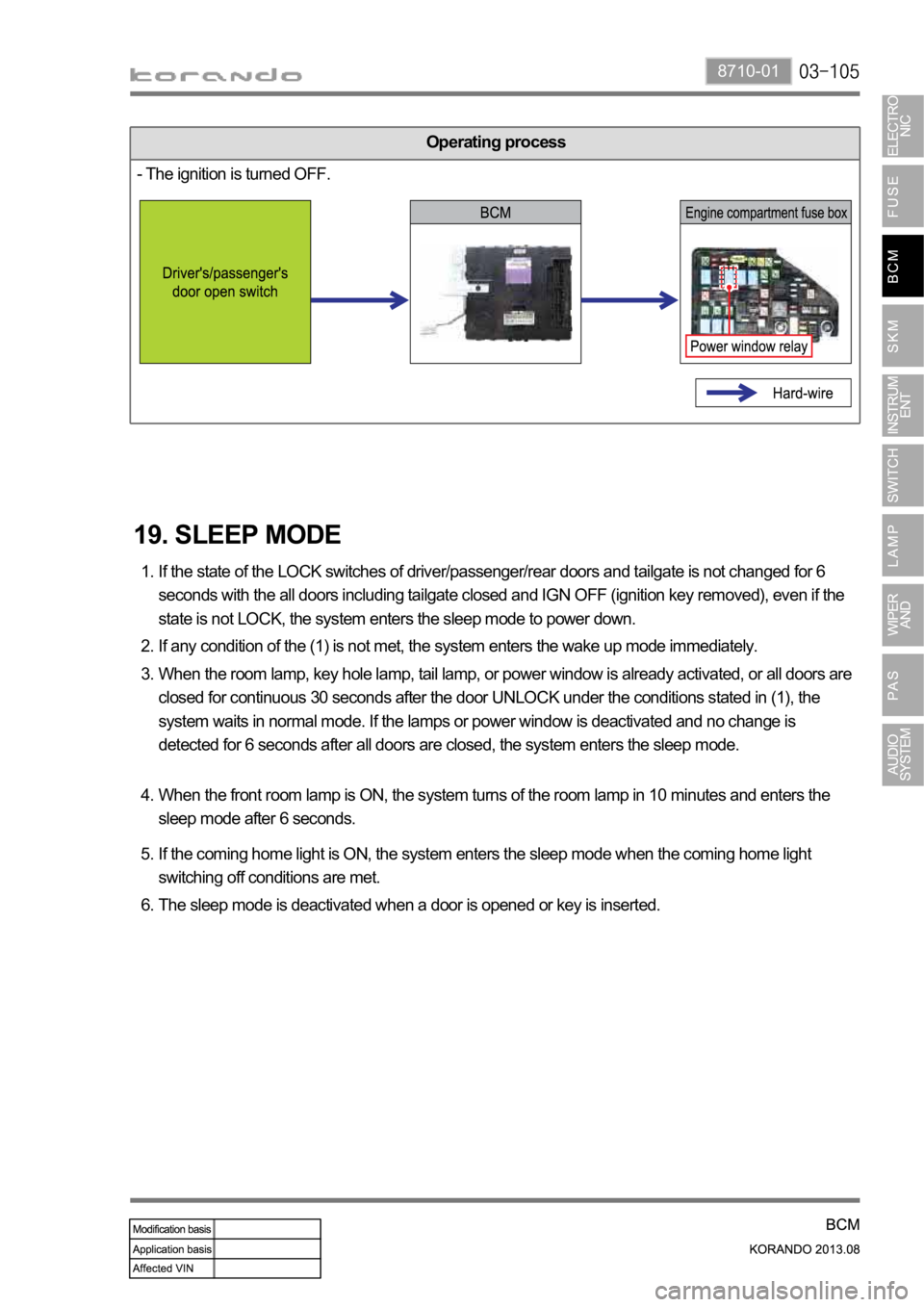
8710-01
Operating process
- The ignition is turned OFF.
19. SLEEP MODE
If the state of the LOCK switches of driver/passenger/rear doors and tailgate is not changed for 6
seconds with the all doors including tailgate closed and IGN OFF (ignition key removed), even if the
state is not LOCK, the system enters the sleep mode to power down. 1.
If any condition of the (1) is not met, the system enters the wake up mode immediately. 2.
When the room lamp, key hole lamp, tail lamp, or power window is already activated, or all doors are
closed for continuous 30 seconds after the door UNLOCK under the conditions stated in (1), the
system waits in normal mode. If the lamps or power window is deactivated and no change is
detected for 6 seconds after all doors are closed, the system enters the sleep mode. 3.
When the front room lamp is ON, the system turns of the room lamp in 10 minutes and enters the
sleep mode after 6 seconds. 4.
If the coming home light is ON, the system enters the sleep mode when the coming home light
switching off conditions are met. 5.
The sleep mode is deactivated when a door is opened or key is inserted. 6.
Page 740 of 1336
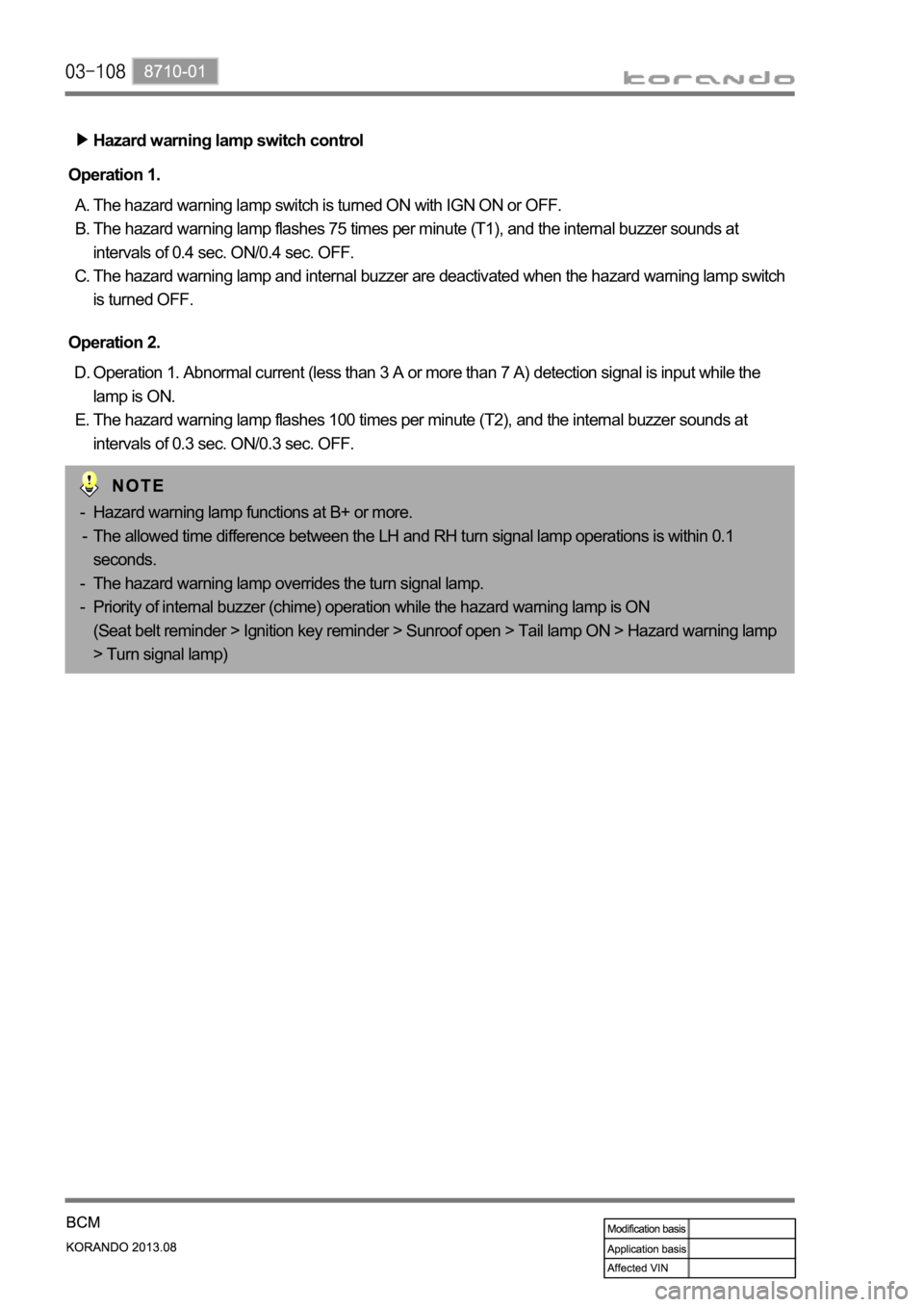
Hazard warning lamp switch control
The hazard warning lamp switch is turned ON with IGN ON or OFF.
The hazard warning lamp flashes 75 times per minute (T1), and the internal buzzer sounds at
intervals of 0.4 sec. ON/0.4 sec. OFF.
The hazard warning lamp and internal buzzer are deactivated when the hazard warning lamp switch
is turned OFF. A.
B.
C. Operation 1.
Operation 1. Abnormal current (less than 3 A or more than 7 A) detection signal is input while the
lamp is ON.
The hazard warning lamp flashes 100 times per minute (T2), and the internal buzzer sounds at
intervals of 0.3 sec. ON/0.3 sec. OFF. D.
E. Operation 2.
Hazard warning lamp functions at B+ or more.
The allowed time difference between the LH and RH turn signal lamp operations is within 0.1
seconds.
The hazard warning lamp overrides the turn signal lamp.
Priority of internal buzzer (chime) operation while the hazard warning lamp is ON
(Seat belt reminder > Ignition key reminder > Sunroof open > Tail lamp ON > Hazard warning lamp
> Turn signal lamp) -
-
-
-
Page 749 of 1336

8710-01
Approach lamp control (for vehicles without SKM)
The lamp is illuminated for 30 seconds when the REKES key UNLOCK signal is received in theft
deterrent mode.
The lamp is illuminated when the driver door is opened after the ignition is turned OFF. A.
B. Operation 1. (Puddle lamp ON conditions)
When the door LOCK signal is received with the lamp ON (the system enters the theft deterrent
mode)
When the ignition is turned ON with the lamp ON.
Thirty seconds after the lamp ON C.
D.
E. Operation 2. (Puddle lamp OFF conditions)
22. APPROACH (PUDDLE) LAMP
Approach lamp control (for vehicles with SKM)
The lamp is illuminated for 30 seconds when UNLOCK signal by the smart key or door handle switch
is received in theft deterrent mode.
The lamp is illuminated when the driver door is opened after the ignition is turned OFF. A.
B. Operation 1. (Puddle lamp ON conditions)
When the door LOCK signal is received with the lamp ON (the system enters the theft deterrent
mode)
When the ignition is turned ON with the lamp ON.
Thirty seconds after the lamp ON C.
D.
E. Operation 2. (Puddle lamp OFF conditions)
Page 751 of 1336

8710-01
24. IMMOBILIZER SYSTEM
1) System Description
The BCM without SKM communicates with the transponder in the REKES key and immobilizer unit in
the key box through wireless communication. The immobilizer unit and BCM check the encrypted codes
received through hard wire communication to start the engine.
Stays on: Communication failure between immobilizer and EMS (ECU)
Flashes: Immobilizer coding failure (once per second)
2) System Diagram
Page 752 of 1336

3) Immobilizer Ignition Key Verification
When turning the ignition key to the ON position, the power is supplied to the immobilizer unit and EMS
(ECU). The ECU communicates with the immobilizer unit to verify the key and transponder. If it is valid,
the ECU starts to control the engine or immobilizer indicator (illumination or flashing) when the ignition key
is turned to the START position.
Once the key is verified, valid key verification time is provided for 10 seconds and the engine can be
started by turning the ignition key to the engine START position during this verification time. If the ignition
key is turned to the START position again after the 10 seconds of verification time, the key verification
should be reperformed.
When the ignition key is inserted, the immobilizer unit requests the transponder verification through
the antenna.
The transponder sends the encrypted message to the immobilizer control unit.
The immobilizer unit compares the encrypted message received from the transponder to the
coded value through the logic circuit. If they are identical, it requests the transponder approval.
When the ignition is turned ON, the EMS (ECU) requests immobilizer verification process through
the P-CAN.
The immobilizer control unit sends the encrypted message to the EMS (ECU).
The EMS controls the engine normally when the coded value and the encrypted message sent
from the immobilizer are identical. 1.
2.
3.
4.
5.
6.
When the immobilizer verification has failed, the verification signal is sent again 3 times for 2
seconds, and the verification procedure is carried out up to 3 times by turning the ignition ON within
10 seconds. If the three re-verifications fail, verification procedure is stopped and will be restarted
after 10 seconds.
Page 753 of 1336
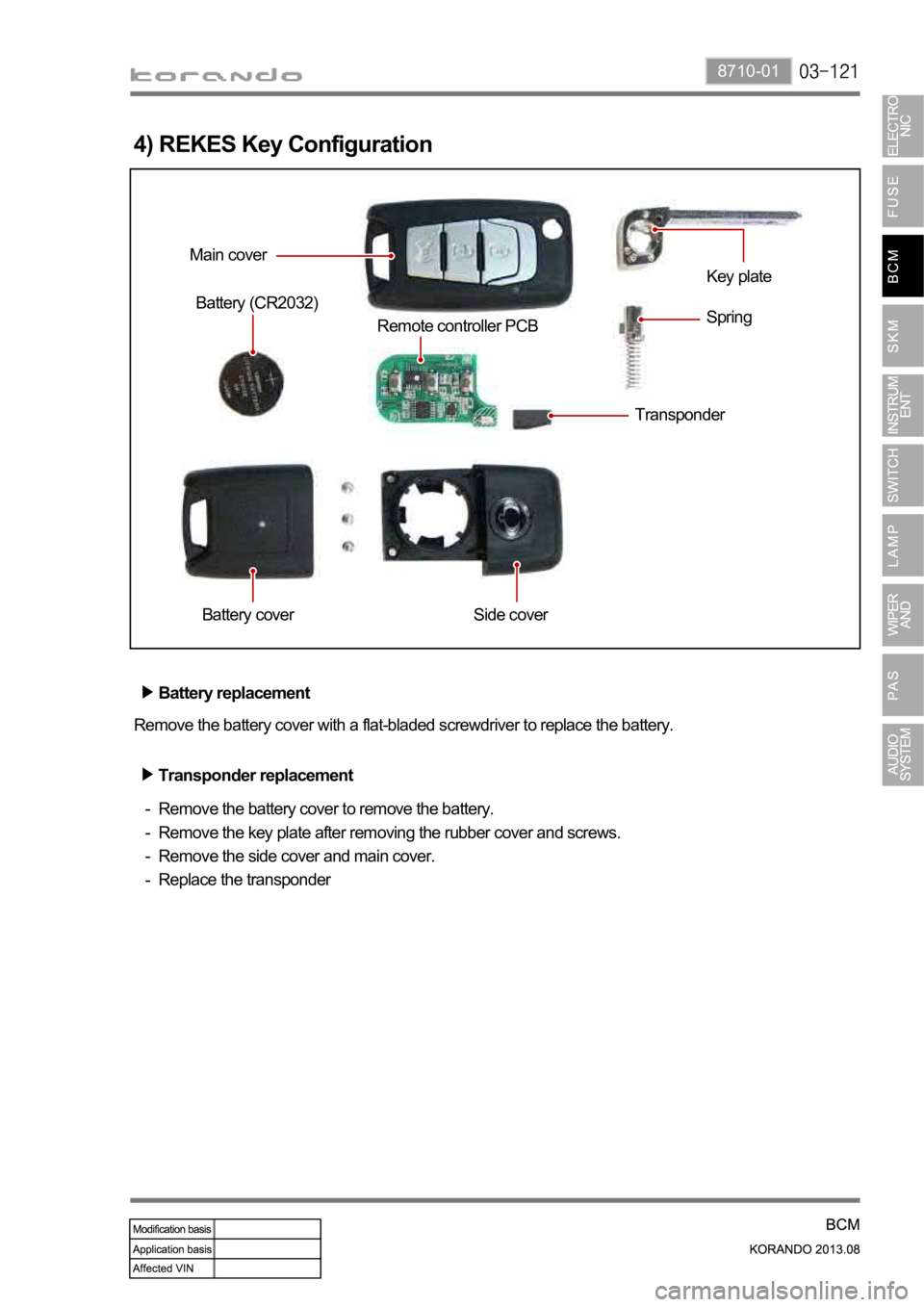
8710-01
4) REKES Key Configuration
Battery cover Side cover Battery (CR2032)
TransponderKey plate
Remote controller PCB
Battery replacement
Remove the battery cover with a flat-bladed screwdriver to replace the battery.
Transponder replacement
Remove the battery cover to remove the battery.
Remove the key plate after removing the rubber cover and screws.
Remove the side cover and main cover.
Replace the transponder -
-
-
-Main cover
Spring
Page 754 of 1336
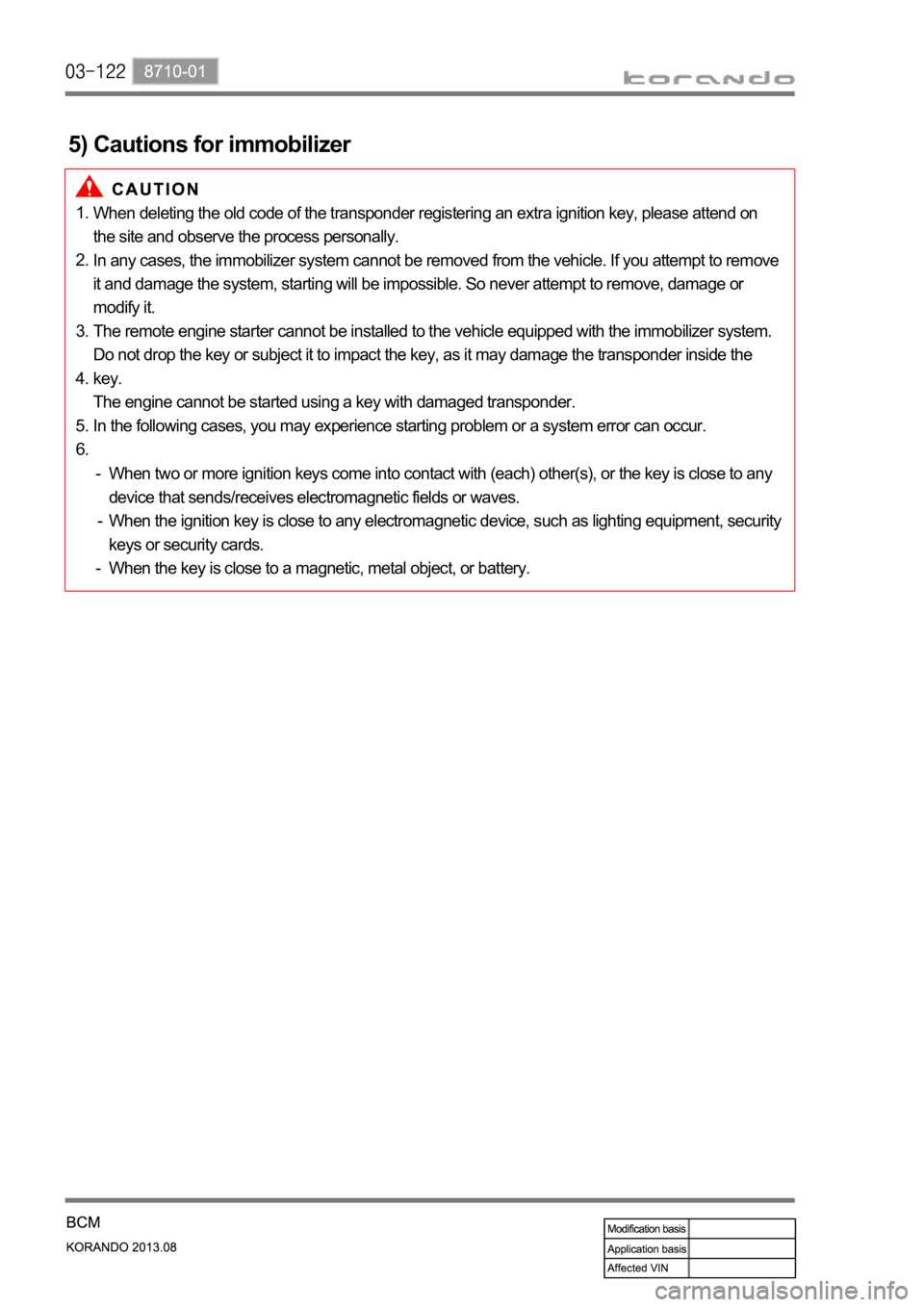
When deleting the old code of the transponder registering an extra ignition key, please attend on
the site and observe the process personally.
In any cases, the immobilizer system cannot be removed from the vehicle. If you attempt to remove
it and damage the system, starting will be impossible. So never attempt to remove, damage or
modify it.
The remote engine starter cannot be installed to the vehicle equipped with the immobilizer system.
Do not drop the key or subject it to impact the key, as it may damage the transponder inside the
key.
The engine cannot be started using a key with damaged transponder.
In the following cases, you may experience starting problem or a system error can occur. 1.
2.
3.
4.
5.
6.
5) Cautions for immobilizer
When two or more ignition keys come into contact with (each) other(s), or the key is close to any
device that sends/receives electromagnetic fields or waves.
When the ignition key is close to any electromagnetic device, such as lighting equipment, security
keys or security cards.
When the key is close to a magnetic, metal object, or battery. -
-
-
Page 755 of 1336

8712-03
Smart key module
1. SPECIFICATIONS
Component Item Specifications
SKM unit
(Electric)Rated voltage 12.0 V
Operating voltage9.0 V to 16.0 V
(CAN: 6.0 V to 18.0 V)
Operation temperature
Max. operating humidity 95%
Dark current 5.5 mA
Voltage drop 1.0 V or less
SKM unit
(wireless)Receive frequency
Frequency bandwidth
Modulation typeFSK
(Frequency Shift Keying)
Receive distanceRF: 10 m or more (without obstacles)
LF: 1.2 m (without obstacles)
Smart key
Component Item Specifications
Smart key
(Electric)Operating voltage 2.7 V to 3.3 V
Operation temperature
Battery type CR2032
Smart key
(wireless)RF (Radio
Frequency)
(transmission)LF (Low Frequency)
(receiving)
Sending/receiving
frequency
Modulation typeFSK
(Frequency Shift Keying)
Page 756 of 1336

LF (Low Frequency) antenna
External buzzer (SKM buzzer)
Component Item Specifications
Smart key antennaFrequency
Current consumption Max. 1.2 A
Operating temperature
range
Door handle switchRated voltage 5.0 V
Voltage range 6.0 V to 16.0 V
Rated current 5 to 20 mA
Operating temperature
range
Component Item Specifications
External buzzer
(SKM buzzer)Operating voltage 7.5 V to 14.5 V
Operation temperature
Sound pressure level 83 dB
Page 758 of 1336
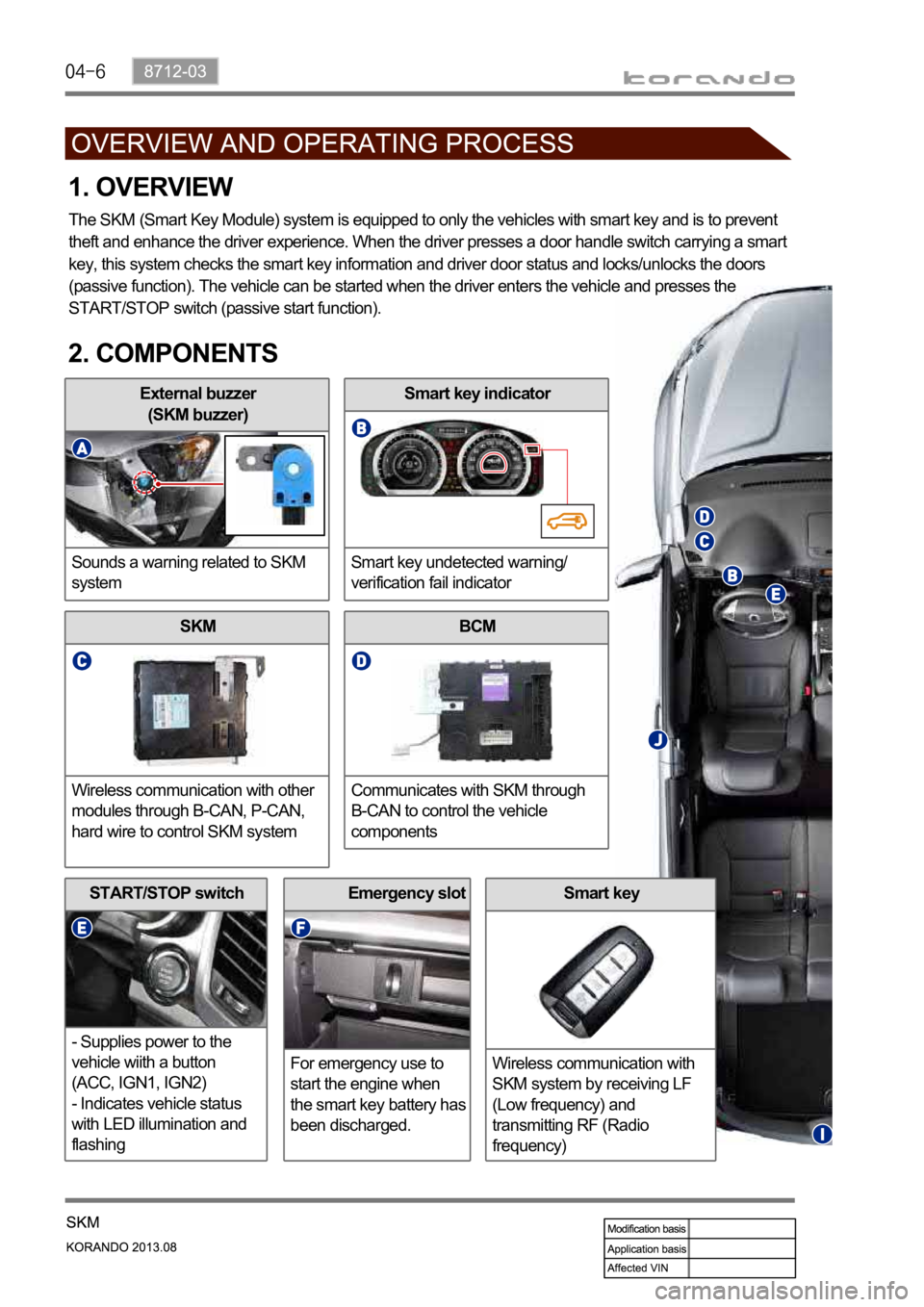
Smart key
Wireless communication with
SKM system by receiving LF
(Low frequency) and
transmitting RF (Radio
frequency)Emergency slot
For emergency use to
start the engine when
the smart key battery has
been discharged.
SKM
Wireless communication with other
modules through B-CAN, P-CAN,
hard wire to control SKM system
External buzzer
(SKM buzzer)
Sounds a warning related to SKM
system
START/STOP switch
- Supplies power to the
vehicle wiith a button
(ACC, IGN1, IGN2)
- Indicates vehicle status
with LED illumination and
flashing
1. OVERVIEW
The SKM (Smart Key Module) system is equipped to only the vehicles with smart key and is to prevent
theft and enhance the driver experience. When the driver presses a door handle switch carrying a smart
key, this system checks the smart key information and driver door status and locks/unlocks the doors
(passive function). The vehicle can be started when the driver enters the vehicle and presses the
START/STOP switch (passive start function).
2. COMPONENTS
Smart key indicator
Smart key undetected warning/
verification fail indicator
BCM
Communicates with SKM through
B-CAN to control the vehicle
components